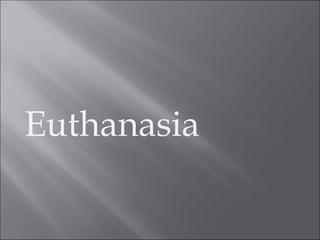death
- 1. Euthanasia
- 2. Euthanasia - refers to the practice of ending a life in a painless manner. Many different forms of euthanasia can be distinguished, including animal euthanasia and human euthanasia, and within the latter, voluntary and involuntary euthanasia. Voluntary euthanasia and physician-assisted suicide have been the focus of great controversy in recent years.
- 3. The term euthanasia comes from the Greek words "eu"-meaning good and "thanatos"-meaning death, which combined means âwell-deathâ or "dying well". Hippocrates mentions euthanasia in the Hippocratic Oath, which was written between 400 and 300 B.C. The original Oath states: âTo please no one will I prescribe a deadly drug nor give advice which may cause his death.â
- 4. Despite this, the ancient Greeks and Romans generally did not believe that life needed to be preserved at any cost and were, in consequence, tolerant of suicide in cases where no relief could be offered to the dying or, in the case of the Stoics and Epicureans, where a person no longer cared for his life.
- 5. English Common Law from the 1300s until the middle of the last century made suicide a criminal act in England and Wales. Assisting others to kill themselves remains illegal in that jurisdiction. However, in the 1500s, Thomas More, in describing a utopian community, envisaged such a community as one that would facilitate the death of those whose lives had become burdensome as a result of "torturing and lingering pain".
- 6. Euthanasia by consent Euthanasia may be conducted with consent (voluntary euthanasia) or without consent (involuntary euthanasia). Involuntary euthanasia is conducted where an individual makes a decision for another person incapable of doing so.
- 7. Euthanasia may be conducted passively, non-actively, and actively. Passive euthanasia entails the withholding of common treatments (such as antibiotics, chemotherapy in cancer, or surgery) or the distribution of a medication (such as morphine) to relieve pain, knowing that it may also result in death (principle of double effect).
- 8. Passive euthanasia is the most accepted form, and it is a common practice in most hospitals. Non-active euthanasia entails the withdrawing of life support and is more controversial. Active euthanasia entails the use of lethal substances or forces to kill and is the most controversial means. An individual may use a euthanasia machine to perform euthanasia on himself / herself.
- 9. Choice: Proponents of VE emphasize that choice is a fundamental principle for liberal democracies and free market systems Quality of Life: The pain and suffering a person feels during a disease, even with pain relievers, can be incomprehensible to a person who has not gone through it. Even without considering the physical pain, it is often difficult for patients to overcome the emotional pain of losing their independence
- 10. Economic costs and human resources: Today in many countries there is a shortage of hospital space. The energy of doctors and hospital beds could be used for people whose lives could be saved instead of continuing the life of those who want to die which increases the general quality of care and shortens hospital waiting lists. It is a burden to keep people alive past the point they can contribute to society, especially if the resources used could be spent on a curable ailment.
- 11. Professional role: Critics argue that voluntary euthanasia could unduly compromise the professional roles of health care employees, especially doctors. They point out that European physicians of previous centuries traditionally swore some variation of the Hippocratic Oath, which in its ancient form excluded euthanasia: "To please no one will I prescribe a deadly drug nor give advice which may cause his death.." However, since the 1970s, this oath has largely fallen out of use.
- 12. Moral/Theological: Some people, including many Christians, consider euthanasia of some or all types to be morally unacceptable. This view usually treats euthanasia to be a type of murder and voluntary euthanasia as a type of suicide, the morality of which is the subject of active debate. Necessity: If there is some reason to believe the cause of a patient's illness or suffering is or will soon be curable, the correct action is sometimes considered to attempt to bring about a cure or engage in palliative care.
- 13. Feasibility of implementation: Euthanasia can only be considered "voluntary" if a patient is mentally competent to make the decision, i.e., has a rational understanding of options and consequences. Competence can be difficult to determine or even define. Consent under pressure: Given the economic grounds for voluntary euthanasia (VE), critics of VE are concerned that patients may experience psychological pressure to consent to voluntary euthanasia rather than be a financial burden on their families. Even where health costs are mostly covered by public money, as in various European countries, VE critics are concerned that hospital personnel would have an economic incentive to advise or pressure people toward euthanasia consent.
- 14. Christianity The declaration on Euthanasia is the Roman Catholic Church's official document on the topic of euthanasia, a statement that was issued as by the Sacred Congregation for the Doctrine of the Faith in 1980.
- 15. Catholic teaching condemns euthanasia as a "crime against life". The teaching of the Catholic Church on euthanasia rests on several core principles of Catholic ethics, including the sanctity of human life, the dignity of the human person, concomitant human rights, due proportionality in casuistic remedies, the unavoidability of death, and the importance of charity.
- 16. With regards to no voluntary euthanasia, the cases where the person could consent but was not asked are often viewed differently from those where the person could not consent. Some people raise issues regarding stereotypes of disability that can lead to non-disabled or less disabled people overestimating the person's suffering, or assuming it to be unchangeable when it could be changed.
- 17. Reported by: Daryll Navarro Mark Sequito Vermont Ventura
















